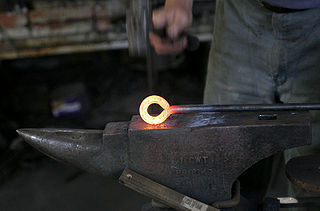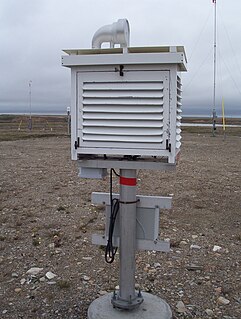
ISO 9060, Specification and classification of instruments for measuring hemispherical solar and direct solar radiation, is an ISO standard for the classification of pyranometers and pyrheliometers. [1]

ISO 9060, Specification and classification of instruments for measuring hemispherical solar and direct solar radiation, is an ISO standard for the classification of pyranometers and pyrheliometers. [1]

A solar flare is a sudden flash of increased brightness on the Sun, usually observed near its surface and in close proximity to a sunspot group. Powerful flares are often, but not always, accompanied by a coronal mass ejection. Even the most powerful flares are barely detectable in the total solar irradiance.

Pioneer P-30 was intended to be a lunar orbiter probe, but the mission failed shortly after launch on September 25, 1960. The objectives were to place a highly instrumented probe in lunar orbit, to investigate the environment between the Earth and Moon, and to develop technology for controlling and maneuvering spacecraft from Earth. It was equipped to estimate the Moon's mass and topography of the poles, record the distribution and velocity of micrometeorites, and study radiation, magnetic fields, and low frequency electromagnetic waves in space. A mid-course propulsion system and injection rocket would have been the first United States self-contained propulsion system capable of operation many months after launch at great distances from Earth and the first U.S. tests of maneuvering a satellite in space.

Pioneer P-31 was intended to be a lunar orbiter probe, but the mission failed shortly after launch. The objectives were to place a highly instrumented probe in lunar orbit, to investigate the environment between the Earth and Moon, and to develop technology for controlling and maneuvering spacecraft from Earth. It was equipped to take images of the lunar surface with a television-like system, estimate the Moon's mass and topography of the poles, record the distribution and velocity of micrometeorites, and study radiation, magnetic fields, and low frequency electromagnetic waves in space. A midcourse propulsion system and injection rocket would have been the first United States self-contained propulsion system capable of operation many months after launch at great distances from Earth and the first U.S. tests of maneuvering a satellite in space.

A light meter is a device used to measure the amount of light. In photography, a light meter is used to determine the proper exposure for a photograph. The meter will include either a digital or analog calculator which displays the correct shutter speed and f-number for optimum exposure, given a certain lighting situation and film speed. Similarly, exposure meters are also used in the fields of cinematography and scenic design, in order to determine the optimum light level for a scene.

The Infrared Space Observatory (ISO) was a space telescope for infrared light designed and operated by the European Space Agency (ESA), in cooperation with ISAS and NASA. The ISO was designed to study infrared light at wavelengths of 2.5 to 240 micrometres and operated from 1995 to 1998.

The emissivity of the surface of a material is its effectiveness in emitting energy as thermal radiation. Thermal radiation is electromagnetic radiation that may include both visible radiation (light) and infrared radiation, which is not visible to human eyes. The thermal radiation from very hot objects is easily visible to the eye. Quantitatively, emissivity is the ratio of the thermal radiation from a surface to the radiation from an ideal black surface at the same temperature as given by the Stefan–Boltzmann law. The ratio varies from 0 to 1. The surface of a perfect black body emits thermal radiation at the rate of approximately 448 watts per square metre at room temperature ; all real objects have emissivities less than 1.0, and emit radiation at correspondingly lower rates.
A pyranometer is a type of actinometer used for measuring solar irradiance on a planar surface and it is designed to measure the solar radiation flux density (W/m2) from the hemisphere above within a wavelength range 0.3 μm to 3 μm. The name pyranometer stems from the Greek words πῦρ (pyr), meaning "fire", and ἄνω (ano), meaning "above, sky".

Solar irradiance is the power per unit area received from the Sun in the form of electromagnetic radiation as measured in the wavelength range of the measuring instrument. The solar irradiance is measured in watt per square metre (W/m2) in SI units. Solar irradiance is often integrated over a given time period in order to report the radiant energy emitted into the surrounding environment during that time period. This integrated solar irradiance is called solar irradiation, solar exposure, solar insolation, or insolation.

A Stevenson screen or instrument shelter is a shelter or an enclosure to meteorological instruments against precipitation and direct heat radiation from outside sources, while still allowing air to circulate freely around them. It forms part of a standard weather station and holds instruments that may include thermometers, a hygrometer, a psychrometer, a dewcell, a barometer, and a thermograph.

A solarimeter is a pyranometer, a type of measuring device used to measure combined direct and diffuse solar radiation. An integrating solarimeter measures energy developed from solar radiation based on the absorption of heat by a black body. The principle this instrument was designed on was first developed by the Italian priest, Father Angelo Bellani. He invented the actinometric method which is based on physical and chemical techniques.

Hemispherical photography, also known as canopy photography, is a technique to estimate solar radiation and characterize plant canopy geometry using photographs taken looking upward through an extreme wide-angle lens or a fisheye lens. Typically, the viewing angle approaches or equals 180-degrees, such that all sky directions are simultaneously visible. The resulting photographs record the geometry of visible sky, or conversely the geometry of sky obstruction by plant canopies or other near-ground features. This geometry can be measured precisely and used to calculate solar radiation transmitted through plant canopies, as well as to estimate aspects of canopy structure such as leaf area index. Detailed treatments of field and analytical methodology have been provided by Paul Rich and Robert Pearcy (1989).

A net radiometer is a type of actinometer used to measure net radiation (NR) at the Earth's surface for meteorological applications. The name net radiometer reflects the fact that it measures the difference between downward/incoming and upward/outgoing radiation from Earth. It is most commonly used in the field of ecophysiology.
ISO 25178: Geometric Product Specifications (GPS) – Surface texture: areal is an International Organisation for Standardisation collection of international standards relating to the analysis of 3D areal surface texture.

A pyrheliometer is an instrument for measurement of direct beam solar irradiance. Sunlight enters the instrument through a window and is directed onto a thermopile which converts heat to an electrical signal that can be recorded. The signal voltage is converted via a formula to measure watts per square metre.
Lagrange is a 2018 concept study for a solar weather mission by the European Space Agency (ESA). This is a British-led concept that envisions two spacecraft to be positioned at Lagrangian points L1 and L5.

Photovoltaic system performance is the ratio of actual solar PV system output compared with expected values, which is essential for proper solar PV facility's operation and maintenance. The performance of a solar PV facility is a function of the climatic conditions, the equipment used and the system configuration. The primary energy input is the global light irradiance in the plane of the solar arrays, and this in turn is a combination of the direct and the diffuse radiation.

An albedometer is an instrument used to measure the albedo of a surface. An albedometer is mostly used to measure the reflectance of earths surface. Often it consists of two pyranometers: one facing up towards the sky and one facing down towards the surface. From the ratio of incoming and reflecting radiation the albedo can be calculated.